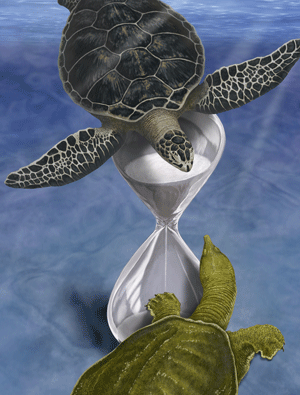Jun. 28, 2013 Research Highlight Biology
Genomic analysis solves the turtle mystery
One of the greatest evolutionary puzzles succumbs to molecular genetics
 Figure 1: The turtle, although unique in many ways, follows the standard ‘hourglass’ model of vertebrate embryonic development before developing its distinct features. © 2013 Naoki Irie, RIKEN Center for Developmental Biology
Figure 1: The turtle, although unique in many ways, follows the standard ‘hourglass’ model of vertebrate embryonic development before developing its distinct features. © 2013 Naoki Irie, RIKEN Center for Developmental Biology
The turtle has always been considered somewhat odd in evolutionary terms. In addition to lacking the hole in the skull—the temporal fenestra—that is characteristic of the egg-laying amniotes, the structure of its shell differs from that of other armored tetrapods such as the armadillo, and its shoulder blades are inside rather than outside the rib cage. An international research team led by Naoki Irie of the RIKEN Center for Developmental Biology has now shown through genomic analysis that turtles are most closely related to crocodiles and birds, and that their embryonic development follows the latest ‘hourglass’ model of vertebrate embryology1.
Evolutionary relationships have traditionally been established by comparing differences in anatomical and structural features. However, with features inconsistent with the traditional lineages, the turtle has proved difficult to place, resulting in at least three different hypotheses for its evolution.
The international team, which included researchers from BGI and the Ensembl genome database project, instead sought to establish the evolutionary position of the turtle based on its genome, which conserves information that can be traced back to its evolutionary ancestors. To do this they sequenced and analyzed the genomes of two very different turtle species—a Chinese soft-shell turtle and the green sea turtle—and then compared their findings with other vertebrates.
The result was clear verification that the closest evolutionary relatives of turtles are crocodiles and birds, from which they diverged about 250 million years ago. In their analysis of the turtle genome, the researchers identified a large number of olfactory receptors but few taste receptors, suggesting that turtles potentially have a sophisticated sense of smell.
The research team also investigated the activity of genes during turtle embryonic development and found that shell formation, which in turtles represents a transformation of vertebrae and ribs, was accompanied by evidence of gene activity normally associated with the formation of limbs.
Despite their unique features, however, turtles appear to follow the same basic ‘hourglass’ model of development as many other vertebrates. Although their early and late embryonic development stages are distinctive, in between turtle embryos go through a bottleneck, or phylotypic stage, in which a body plan typical of vertebrates is laid down. This suggests that rather than diverging into specialized animals from the outset, turtles develop in the same way as basic vertebrates and only later enter a turtle-specific developmental phase.
“We do not yet know the diversity of animals which follow this hourglass model or why they ended up with it,” Irie says. “These are the questions I want to tackle next.”
References
- 1. Wang, Z., Pascual-Anaya, J., Zadissa, A., Li, W., Niimura, Y., Huang, Z., Li, C., White, S., Xiong, Z., Fang, D. et al. The draft genomes of soft-shell turtle and green sea turtle yield insights into the development and evolution of the turtle-specific body plan. Nature Genetics 45, 701–706 (2013). doi: 10.1038/ng.2615
